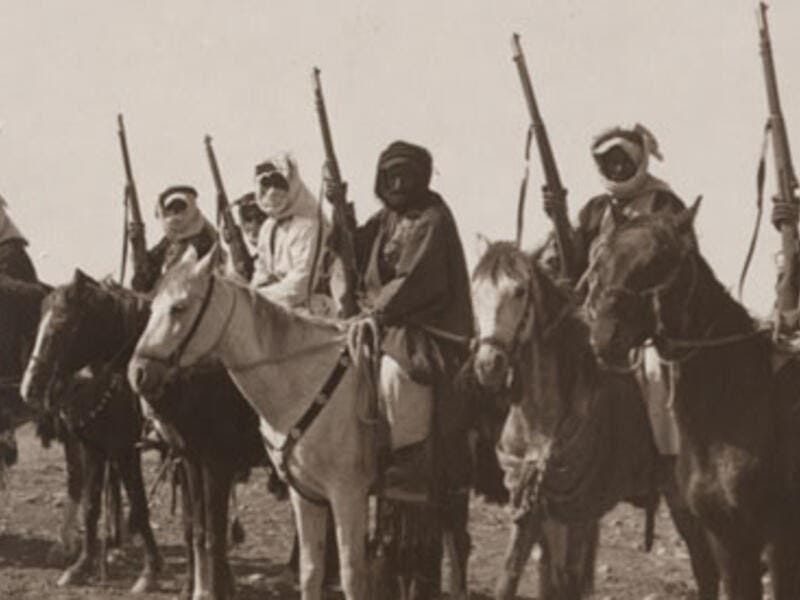Tribes and Tribalism in the Middle East
From ancient identities to modern traditions
“What goes up, must come down”
In 2018, I climbed into the back seat of a white mercedes, dressed in a suitcoat and stuffed like a can of sardines. The smell of cigarette smoke came off the young man driving, who took upon himself as a friend of the groom-to-be, to bring his American friends to the “Jaha,” or tribal engagement ceremony. We set off several hours south to a city in southern Jordan where we were joined by hundreds of tribesmen from some of Jordan’s leading tribal families.
The event was brief. Hundreds of people packed into a road-side tent, which was decorated with traditional bedouin imagery—the black, red, and white woven Jordanian design pattern, the red and white shmokh head dress worn by elders of the familiy, and aged bronze and brass coffee pots. The male heads of both families gathered together at the center to review and sign the marriage contract, ending a multistep pre-engagement process by which is traditionally undertaken both families. This process includes a series of consulations between the groom-to-be with the the men of the bride-to-be’s family, as well as between interactions between their mothers, to determine the logistics and feasibility of the union.
After signing the nuptuals, hundreds of plates of Jordan’s delectable sweet “kanafa” - a melted sweet cheese pastry - were handed out to celebrate the union. As attendees consumed the 1000+ calorie dessert, men from the tribe fired rounds from firearms and the odd AK-47 into the air at a safe distance from the tent. This show of strength from the groom-to-be’s tribe traditionally aims to project an image of tribal power and strength and signal to the attendees of their ability to protect the bride-to-be as she joined became a member of the tribe through marriage.
After nervously singing the famous line from the Blood Sweat & Tear’s “Spinning Wheel” - “What goes up, must come down,” I ventured out of the tent toward the white mercedes praying none of the shots fired in the air would come down on my head. We climbed in the car, and headed back to Amman.
The Jaha was one of the most distinct examples of an ancient, turned modern tradition shared among bedouin tribes in Jordan. Such traditions have spanned decades, centuries, and, in some cases, millenia. Across the Middle East, tribes form a core unit of society, and continue to carry much of the history and culture of the region.
A deeper history of Arab tribes
Arab tribes find their origins in two ancient Arab tribes from Arab Gulf and Middle East region during time of Abraham, the Qahtani and the Adnani, according to tradition. The Qahtani originated from the southern Arab Peninsula particularly in Yemen. Often they are referred to as the Arab Koh or the pure Arabs. The Adnani are commonly referred to as the Arabized-Arabs because they originated from areas north of the Arab peninsula, the modern Levant. Adnani are believed to be descendants of Ishmael, the son of Abraham. The phrase “Arabized-Arabs” comes from the belief that Ishmael originally spoke Hebrew before journeying to Mecca where He was arabized after marrying a woman from a Qahtani tribe. As the validity of the narrative can be debated, the important distinction to be made between the two tribes are their origins. While the Qahtani are considered “pure Arab”, the importance of the Adnani connection to Abraham in tradition must be noted. The significance of the Adnani-Ishmael connection provided the contextual claim of Muhammad as the seal of prophets because it places him in the genealogy of Abraham.
The distinction between the two tribes historically tends to impact the historical context of tribes more than the modern context. With the expansion of Islam and the Muslim Empire from the Arab Gulf into the rest of the Levant and North Africa, there was an inevitable movement and settlement of these tribes into new areas. One of many examples of this early migration are the Shammar, a Qahtani tribe that is found in Jordan, Iraq, and Syria. Like the Shammar, Qahtani tribes have been living in the Levant for centuries.
It is difficult to fully define the term tribe in the Arab context due to the various types of social structures and groups that exist within Arab history. The Arabic word “qabila” that is most often translated as tribe in English was incorporated into Turkish, Persian, and Berber. Each language represents a very distinct definition of what “qabila” means and its various distinguishable characteristics. Broadly defined, nomadic cohesion among early Arab tribes was described by Ibn Khaldun in his work Muqaddimah with the Arabic word ‘asabyia. At the time, his depiction of tribal solidarity was broadly applied to tribes in his time period that were in predominantly Arabic-speaking countries. Simply put, ‘asabiya is defined as the fundamental connections or “social glue” within a tribal society that sustain social cohesion among the members therein. These connections were built and strengthened by marriage, kinship, blood, religion, and common ancestry.
Kinship and Ancestry
Two of the previous elements in tribal formation that define the social structure are common ancestry and kinship. The first introduced by Albert Hourani suggests that that tribal solidarity is owed not to kinship per se but to “a myth of common ancestry” by which tribes are linked by a historical connection (whether fictitious or legendary) to an important historical or religious figure. This is exemplified in the assumption that Qahtani are truly “pure Arab.” Rather, the connection falls into the realm of myth. The second suggests that tribal solidarity is in fact owed to collective kinship. Hourani is correct in his assertion that tribes find a degree of solidarity in “the myth of common ancestry” especially in tribes embracing Islam where the common ancestor has religious significance. However, common ancestry, as important as it is, is not reinforced in the modern day since these historic connections are often outdated. The inconsistency in tribal labeling alludes to a process by which family structures redefine themselves as a tribe. Through the establishment of family and marriage connections, kinship groups provide a deep solidarity between Arab tribes in the modern context.
Arab tribes predate Islam and extend well into the pre-Islamic period. Major tribes in the Arab Peninsula include variations of many modern tribes including the Anizah and Hashemites (the Royal Family of Jordan). Without a central state in the Arab Peninsula during the pre-Islamic period, tribes and tribal society dictated daily life, trade, security, and sustenance. Historic customs laid the foundation for many, but not all, of the modern tribal customs found in the region today. With the rise of Islam, tribalism adopted a level of religious significance. Islam both challenged and complimented the role of tribes in daily life.
© Jesse Marks, Coffee in the Desert
For further reading:
Albert Hourani, “A History of the Arab Peoples,”
Ibn Khaldun, “Introduction to History”




